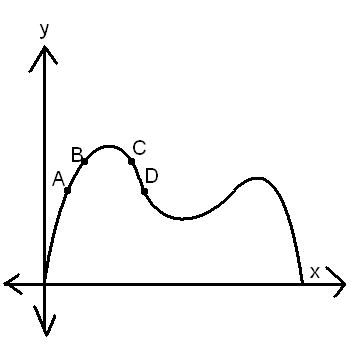--Well, I sort of went overboard on this, to be honest. I quite possibly overshot what can be considered reasonable expectations for regular 9th-graders. But, I was so impressed by my 9th-graders. I gave every student of mine -- honors and regular -- a very algebraically rigorous proof. I decided that of course I'd have to guide them through it by demonstrating a couple of proof parts on the board and then letting them duplicate / struggle through the super long algebra process for the rest of it. It took us two whole classes to do this one proof, but I think it was super worth it.
So, here we go. Student work samples to come, but I am so excited by this worthwhile task that I couldn't wait for those work samples to come in to post about it!! (My regular kids are turning in a draft of their "proof" next class after we fix it up a little and tie in explanations for each step. Their homework tonight is to re-write the proof draft neatly, step-by-step, so that I have a shot at following and verifying everyone's algebra work.) I'm really excited! I had one middle-of-the-road kid in one of my regular classes tell me today that she likes this. I believe she said something about it being really "deep." It made me very happy, and I told her that math in college is all like this -- no numbers! Just variables!
So, here's the prompt:
Prove that if you start with a triangle with coordinates M(0,0), N(a,b), and P(c,d) and you construct "midsegments" going from one midpoint to another, then each of your midsegments will be parallel to one original edge in the triangle and have only half of the length of that original segment. Assume that a, b, c, and d are all nonzero values.
To balance between letting them try it and guiding them along, I first let them write the goal and the given and to attempt to draw the diagram. Then, as a class we fixed our diagrams so that the midpoints X, Y, Z are all labeled the same way on everyone's paper (so that everyone has segments XY and PM being parallel, for example). I drew this on the board to help guide our discussion:

Then came the intense mini lesson!!
I showed them, step-by-step, an example for how to show using algebra that one midsegment is parallel to an existing edge in the triangle:
$Location\hspace{1mm}of\hspace{1mm}X=(\frac{a-0}{2}, \frac{b-0}{2}) =(\frac{a}{2}, \frac{b}{2})\\\\
\indent Location\hspace{1mm}of\hspace{1mm}Y=(\frac{a+c}{2}, \frac{b+d}{2})\\\\
\indent Slope\hspace{1mm}of\hspace{1mm}\overline{PM} =\frac{rise}{run} = \frac{y_2-y_1}{x_2-x_1} = \frac{d - 0}{c - 0} = \frac{d}{c}\\\\
\indent Slope\hspace{1mm}of\hspace{1mm}\overline{XY} =\frac{rise}{run} = \frac{y_2-y_1}{x_2-x_1} = \frac{(b+d)/2 - b/2}{(a+c)/2 - a/2} = \frac{d/2}{c/2} = \frac{d}{2}\cdot\frac{2}{c} = \frac{d}{c}$
For Day 1, all they worked on the rest of the class (after our mini lesson) was to show that the other two midsegments are also each parallel to an edge in the original triangle. (Believe me, it takes that long for a whole group of kids to each crank through this algebra, since they needed to do it on their own twice, once for each remaining midsegment. If you look closely, for Day 1 alone they would need to be able to algebraically find midpoint and slope, and to correctly add/reduce/divide algebraic fractions.)
Then, on Day 2 (today), I showed the regular classes how to prove using algebra that the midsegment is 1/2 of the length of that original edge (which again involves some hairy algebra, including distance formula, square root simplification, and some fractional operations):
$length\hspace{1mm}of\hspace{1mm}\overline{PM} = \sqrt{rise^2 + run^2} = \sqrt{(d-0)^2 + (c-0)^2} = \sqrt{d^2 + c^2}\\\\
\indent length\hspace{1mm}of\hspace{1mm}\overline{XY} = \sqrt{rise^2 + run^2} = \sqrt{(\frac{b+d}{2} - \frac{b}{2})^2 + (\frac{a+c}{2} - \frac{a}{2})^2} \\
\indent = \sqrt{(\frac{d}{2})^2 + (\frac{c}{2})^2} = \sqrt{\frac{d^2}{4} + \frac{c^2}{4}}= \sqrt{\frac{d^2 + c^2}{4}} = \frac{\sqrt{d^2 + c^2}}{\sqrt{4}} = \frac{\sqrt{d^2 + c^2}}{2}$
Then, just as before, the class had to repeat that process for the other two midsegments. Some of the kids were expectedly getting lost in the algebra, but most of them were able to re-find their ways with some help from their partners, and by the end of the class just about everyone was done with all of the algebra work that is required to complete this proof!
I am SO happy! These are my regular Geometry kids!! It just goes to show, I guess, that I need to dream up what's (im)possible, in order to challenge and to allow my kids to rise to those heights!
PS. I'm trying the new LaTeX in Blogger thing. I think it works ok but the indentation is all messed up. What gives? I had to insert extra indentations in order to make it all line up.
PPS. Um, one kid did cry yesterday. I'm not sure why, to be honest, because when I checked in with her group 5 minutes before she had cried, she was still at a "working-level frustration." Then, she went from zero to crying in 5 minutes. Today she was doing much better, and she got through all the algebra parts in the end, with time to spare! yay. I told her that in the future, she should raise her hand if she feels like crying........... sigh. That's a record-breaker for me, that's for sure.....
Addendum 4/11/11: One exemplary student work sample here.


























